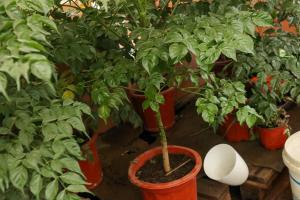What Are the Black Spots on My Tomato Plant Leaves?
Tomato plants are a common sight in many home gardens. These plants produce juicy and flavorful fruits that are used in a wide variety of dishes. However, growing tomato plants can be challenging due to the numerous pests and diseases that can afflict them. One such problem that many gardeners face is the appearance of black spots on the leaves of their tomato plants.
Causes of Black Spots on Tomato Plant Leaves
The appearance of black spots on tomato plant leaves is most commonly caused by a fungal disease called early blight. This disease is caused by the fungus Alternaria solani and usually appears around late June or early July. The fungus causes circular, black lesions with yellow halos to appear on the leaves. As the disease progresses, the spots can merge and cause the leaves to yellow and drop prematurely.
Another fungal disease that can cause black spots on tomato plant leaves is septoria leaf spot. This disease is caused by the fungus Septoria lycopersici and usually appears around mid-June. The fungus causes small, circular black spots to appear on the leaves that can quickly enlarge and cause the leaves to yellow and drop.
Finally, black spots can also be caused by overwatering or poor air circulation around the plants. This can lead to the growth of various fungal diseases that cause black spots to appear.
Treatment and Prevention of Black Spots on Tomato Plant Leaves
To treat fungal diseases such as early blight and septoria leaf spot, it is important to remove all affected leaves immediately and discard them in the trash (do not compost). This can help to slow the spread of the disease. In addition, it is important to water the plants at the base to avoid getting water on the leaves. Fungicides can also be used to treat these diseases, but it is important to follow the instructions carefully.
To prevent the appearance of black spots on tomato plant leaves, it is important to practice good garden hygiene. This includes planting disease-resistant varieties, rotating crops every 2-3 years, keeping the garden clean and weed-free, and providing adequate spacing between plants for good air circulation. In addition, watering the plants regularly and not overwatering can also help to prevent the growth of fungal diseases.
Conclusion
The appearance of black spots on tomato plant leaves can be a significant problem for gardeners. These spots are usually caused by fungal diseases such as early blight and septoria leaf spot, as well as overwatering and poor air circulation. To treat and prevent these diseases, it is important to practice good garden hygiene, remove affected leaves, and use fungicides if necessary. By taking these steps, gardeners can help to ensure healthy, vibrant tomato plants that produce delicious fruits.

 how many times do yo...
how many times do yo... how many planted tre...
how many planted tre... how many pine trees ...
how many pine trees ... how many pecan trees...
how many pecan trees... how many plants comp...
how many plants comp... how many plants can ...
how many plants can ... how many plants and ...
how many plants and ... how many pepper plan...
how many pepper plan...































